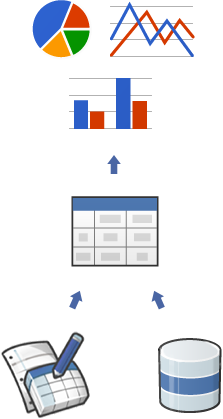
Google Charts เป็นวิธีการแสดงภาพข้อมูลบนเว็บไซต์ที่สมบูรณ์แบบ แผนภูมิแผนภูมิมีแผนภูมิประเภทที่พร้อมใช้งานมากมาย ตั้งแต่แผนภูมิเส้นแบบธรรมดาไปจนถึงแผนผังต้นไม้แบบลําดับชั้นที่ซับซ้อน
วิธีที่ใช้กันโดยทั่วไปสําหรับ Google Charts คือ JavaScript แบบง่ายที่ฝังอยู่ในหน้าเว็บ คุณโหลดไลบรารีของ Google Chart บางรายการ แสดงรายการข้อมูลที่ต้องการสร้างแผนภูมิ เลือกตัวเลือกเพื่อปรับแต่งแผนภูมิ และสุดท้าย สร้างออบเจ็กต์แผนภูมิด้วยรหัสที่คุณเลือก จากนั้นในหน้าเว็บ ให้สร้าง <div> โดยใช้ id นั้นเพื่อแสดงแผนภูมิของ Google
นี่คือทั้งหมดที่คุณต้องการเริ่มต้นใช้งาน
แผนภูมิจะแสดงเป็นคลาส JavaScript และ Google Charts มีแผนภูมิหลายประเภทให้คุณใช้ ลักษณะที่ปรากฏเริ่มต้นมักจะเป็นสิ่งที่คุณต้องการ และคุณสามารถปรับแต่งแผนภูมิได้เสมอเพื่อให้เหมาะกับรูปลักษณ์ของเว็บไซต์ แผนภูมิเป็นเนื้อหาที่มีการโต้ตอบแบบอินเทอร์แอกทีฟและเปิดเผยสูง ซึ่งช่วยให้คุณเชื่อมต่อเพื่อสร้างแดชบอร์ดหรือประสบการณ์อื่นๆ ที่ผสานรวมกับหน้าเว็บที่ซับซ้อนได้ แผนภูมิจะแสดงผลโดยใช้เทคโนโลยี HTML5/SVG เพื่อให้ความเข้ากันได้กับหลายเบราว์เซอร์ (รวมถึง VML สําหรับ IE เวอร์ชันเก่า) และความสามารถในการถ่ายโอนระหว่างแพลตฟอร์มไปยัง iPhone, iPad และ Android ผู้ใช้จะไม่ต้องยุ่งยากกับปลั๊กอินหรือซอฟต์แวร์ใดๆ หากมีเว็บเบราว์เซอร์ ก็จะเห็นแผนภูมิของคุณ
ประเภทแผนภูมิทั้งหมดจะมีข้อมูลโดยใช้คลาส DataTable ซึ่งจะช่วยให้คุณสลับระหว่างแผนภูมิประเภทต่างๆ ได้ง่ายในระหว่างการทดสอบเพื่อค้นหาลักษณะที่เหมาะสม DataTable มีวิธีการจัดเรียง แก้ไข และกรองข้อมูล และสามารถป้อนข้อมูลได้โดยตรงจากหน้าเว็บ ฐานข้อมูล หรือผู้ให้บริการข้อมูลใดๆ ที่รองรับโปรโตคอลแหล่งข้อมูลเครื่องมือแผนภูมิ (โปรโตคอลดังกล่าวใช้ภาษาสืบค้นแบบ SQL และมีการใช้งานโดย Google สเปรดชีต, Google ตารางฟิวชันและผู้ให้บริการข้อมูลบุคคลที่สาม เช่น SalesForce นอกจากนี้คุณยังใช้โปรโตคอลในเว็บไซต์ของคุณเองและกลายเป็นผู้ให้บริการข้อมูลสําหรับบริการอื่นๆ ได้ด้วย)
พร้อมที่จะสร้างแผนภูมิแรกหรือยัง ไปที่คู่มือเริ่มใช้งานฉบับย่อ
เครื่องมือของเราเปลี่ยนแปลงอย่างต่อเนื่องเพื่อให้ตรงตามความต้องการของคุณมากยิ่งขึ้น เราอาศัยความคิดเห็นของคุณในการช่วยเราจัดลําดับความสําคัญของฟีเจอร์ที่จะใส่ เข้าร่วมกลุ่มสนทนา
